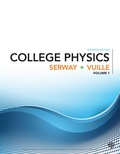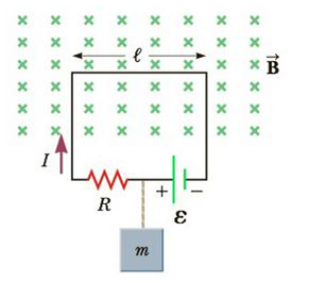
EBK COLLEGE PHYSICS, VOLUME 1
11th Edition
ISBN: 9781337514637
Author: Vuille
Publisher: CENGAGE LEARNING - CONSIGNMENT
expand_more
expand_more
format_list_bulleted
Concept explainers
Textbook Question
Chapter 19, Problem 30P
Mass m = 1.00 kg is suspended vertically at rest by an insulating string connected to a circuit partially immersed in a magnetic field as in Figure P19.30. The magnetic field has magnitude Bin = 2.00 T and the length ℓ = 0.500 m. (a) Find the current I. (b) If ε = 115 V, find the required resistance R.

Figure P19.30
Expert Solution & Answer
Trending nowThis is a popular solution!

Students have asked these similar questions
No chatgpt pls will upvote
No chatgpt pls will upvote
No chatgpt pls will upvote
Chapter 19 Solutions
EBK COLLEGE PHYSICS, VOLUME 1
Ch. 19.3 - A charged particle moves in a straight line...Ch. 19.3 - The north-pole end of a bar magnet is held near a...Ch. 19.5 - As a charged particle moves freely in a circular...Ch. 19.6 - A square and a circular loop with the same area...Ch. 19.8 - Which of the following actions would double the...Ch. 19.8 - Prob. 19.6QQCh. 19 - Prob. 1CQCh. 19 - Prob. 2CQCh. 19 - How can the motion of a charged particle be used...Ch. 19 - Prob. 4CQ
Ch. 19 - The following statements are related to the force...Ch. 19 - Will a nail be attracted to either pole of a...Ch. 19 - Figure CQ19.7 shows a coaxial cable carrying...Ch. 19 - A magnet attracts a piece of iron. The iron can...Ch. 19 - Figure CQ19.9 shows four positive charges, A, B,...Ch. 19 - Is the magnetic field created by a current loop...Ch. 19 - Suppose you move along a wire at the same speed as...Ch. 19 - Why do charged particles from outer space, called...Ch. 19 - A hanging Slinky toy is attached to a powerful...Ch. 19 - How can a current loop he used to determine the...Ch. 19 - Prob. 15CQCh. 19 - Figure CQ19.16 shows four permanent magnets, each...Ch. 19 - Two charged particles are projected in the same...Ch. 19 - Prob. 18CQCh. 19 - A magnetic field exerts a torque on each of the...Ch. 19 - Consider an electron near the Earths equator. In...Ch. 19 - (a) Find the direction of the force on a proton (a...Ch. 19 - Find the direction of the magnetic field acting on...Ch. 19 - Prob. 4PCh. 19 - A laboratory electromagnet produces a magnetic...Ch. 19 - Prob. 6PCh. 19 - Electrons and protons travel from the Sun to the...Ch. 19 - An oxygen ion (O+) moves in the xy-plane with a...Ch. 19 - A proton moving at 4.00 106 m/s through a...Ch. 19 - Sodium ions (Na+) move at 0.851 m/s through a...Ch. 19 - At the equator, near the surface of Earth, the...Ch. 19 - A proton travels with a speed of 5.02 106 m/s at...Ch. 19 - An electron moves in a circular path perpendicular...Ch. 19 - Figure P19.14a is a diagram of a device called a...Ch. 19 - Prob. 15PCh. 19 - A mass spectrometer is used to examine the...Ch. 19 - Jupiters magnetic field occupies a volume of space...Ch. 19 - Electrons in Earths upper atmosphere have typical...Ch. 19 - Prob. 19PCh. 19 - A proton (charge +e, mass mp), a deuteron (charge...Ch. 19 - A particle passes through a mass spectrometer as...Ch. 19 - In Figure P19.2, assume in each case the velocity...Ch. 19 - A current I = 15 A is directed along the positive...Ch. 19 - A straight wire carrying a 3.0-A current is placed...Ch. 19 - In Figure P19.3, assume in each case the velocity...Ch. 19 - A wire having a mass per unit length of 0.500 g/cm...Ch. 19 - A wire carries a current of 10.0 A in a direction...Ch. 19 - At a certain location, Earth has a magnetic field...Ch. 19 - A wire with a mass of 1.00 g/cm is placed on a...Ch. 19 - Mass m = 1.00 kg is suspended vertically at rest...Ch. 19 - Consider the system pictured in Figure P19.31. A...Ch. 19 - A metal rod of mass m carrying a current I glides...Ch. 19 - In Figure P19.33, the cube is 40.0 cm on each...Ch. 19 - A horizontal power line of length 58 m carries a...Ch. 19 - A wire is formed into a circle having a diameter...Ch. 19 - A current of 17.0 mA is maintained in a single...Ch. 19 - An eight-turn coil encloses an elliptical area...Ch. 19 - A current-carrying rectangular wire loop with...Ch. 19 - A 6.00-turn circular coil of wire is centered on...Ch. 19 - The orientation of small satellites is often...Ch. 19 - Along piece of wire with a mass of 0.100 kg and a...Ch. 19 - A rectangular loop has dimensions 0.500 m by 0.300...Ch. 19 - A lightning bolt may carry a current of 1.00 104...Ch. 19 - A long, straight wire going through the origin is...Ch. 19 - Neurons in our bodies carry weak currents that...Ch. 19 - In 1962 measurements of the magnetic field of a...Ch. 19 - A cardiac pacemaker can be affected by a static...Ch. 19 - The two wires shown in Figure P19.48 are separated...Ch. 19 - Prob. 49PCh. 19 - Two long, parallel wires carry currents of I1 =...Ch. 19 - Two long, parallel wires carry currents of I1 =...Ch. 19 - Prob. 52PCh. 19 - The magnetic field 40.0 cm away from a long,...Ch. 19 - Prob. 54PCh. 19 - Prob. 55PCh. 19 - Prob. 56PCh. 19 - A wire with a weight per unit length of 0.080 N/m...Ch. 19 - In Figure P19.58 the current in the long, straight...Ch. 19 - A long solenoid that has 1.00 103 turns uniformly...Ch. 19 - Prob. 60PCh. 19 - It is desired to construct a solenoid that will...Ch. 19 - Certain experiments must be performed in the...Ch. 19 - Ail electron is moving at a speed of 1.0 104 in/s...Ch. 19 - Figure P19.64 is a setup that can be used to...Ch. 19 - Two coplanar and concentric circular loops of wire...Ch. 19 - An electron moves in a circular path perpendicular...Ch. 19 - Prob. 67APCh. 19 - A 0.200-kg metal rod carrying a current of 10.0 A...Ch. 19 - Using an electromagnetic flowmeter (Fig. P19.69),...Ch. 19 - A uniform horizontal wire with a linear mass...Ch. 19 - Prob. 71APCh. 19 - Two long, parallel wires, each with a mass per...Ch. 19 - Protons having a kinetic energy of 5.00 MeV are...Ch. 19 - A straight wire of mass 10.0 g and length 5.0 cm...Ch. 19 - A 1.00-kg ball having net charge Q = 5.00 C is...Ch. 19 - Two long, parallel conductors separated by 10.0 cm...
Knowledge Booster
Learn more about
Need a deep-dive on the concept behind this application? Look no further. Learn more about this topic, physics and related others by exploring similar questions and additional content below.Similar questions
- You are standing a distance x = 1.75 m away from this mirror. The object you are looking at is y = 0.29 m from the mirror. The angle of incidence is θ = 30°. What is the exact distance from you to the image?arrow_forwardFor each of the actions depicted below, a magnet and/or metal loop moves with velocity v→ (v→ is constant and has the same magnitude in all parts). Determine whether a current is induced in the metal loop. If so, indicate the direction of the current in the loop, either clockwise or counterclockwise when seen from the right of the loop. The axis of the magnet is lined up with the center of the loop. For the action depicted in (Figure 5), indicate the direction of the induced current in the loop (clockwise, counterclockwise or zero, when seen from the right of the loop). I know that the current is clockwise, I just dont understand why. Please fully explain why it's clockwise, Thank youarrow_forwardA planar double pendulum consists of two point masses \[m_1 = 1.00~\mathrm{kg}, \qquad m_2 = 1.00~\mathrm{kg}\]connected by massless, rigid rods of lengths \[L_1 = 1.00~\mathrm{m}, \qquad L_2 = 1.20~\mathrm{m}.\]The upper rod is hinged to a fixed pivot; gravity acts vertically downward with\[g = 9.81~\mathrm{m\,s^{-2}}.\]Define the generalized coordinates \(\theta_1,\theta_2\) as the angles each rod makes with thedownward vertical (positive anticlockwise, measured in radians unless stated otherwise).At \(t=0\) the system is released from rest with \[\theta_1(0)=120^{\circ}, \qquad\theta_2(0)=-10^{\circ}, \qquad\dot{\theta}_1(0)=\dot{\theta}_2(0)=0 .\]Using the exact nonlinear equations of motion (no small-angle or planar-pendulumapproximations) and assuming the rods never stretch or slip, determine the angle\(\theta_2\) at the instant\[t = 10.0~\mathrm{s}.\]Give the result in degrees, in the interval \((-180^{\circ},180^{\circ}]\).arrow_forward
- What are the expected readings of the ammeter and voltmeter for the circuit in the figure below? (R = 5.60 Ω, ΔV = 6.30 V) ammeter I =arrow_forwardsimple diagram to illustrate the setup for each law- coulombs law and biot savart lawarrow_forwardA circular coil with 100 turns and a radius of 0.05 m is placed in a magnetic field that changes at auniform rate from 0.2 T to 0.8 T in 0.1 seconds. The plane of the coil is perpendicular to the field.• Calculate the induced electric field in the coil.• Calculate the current density in the coil given its conductivity σ.arrow_forward
- An L-C circuit has an inductance of 0.410 H and a capacitance of 0.250 nF . During the current oscillations, the maximum current in the inductor is 1.80 A . What is the maximum energy Emax stored in the capacitor at any time during the current oscillations? How many times per second does the capacitor contain the amount of energy found in part A? Please show all steps.arrow_forwardA long, straight wire carries a current of 10 A along what we’ll define to the be x-axis. A square loopin the x-y plane with side length 0.1 m is placed near the wire such that its closest side is parallel tothe wire and 0.05 m away.• Calculate the magnetic flux through the loop using Ampere’s law.arrow_forwardDescribe the motion of a charged particle entering a uniform magnetic field at an angle to the fieldlines. Include a diagram showing the velocity vector, magnetic field lines, and the path of the particle.arrow_forward
- Discuss the differences between the Biot-Savart law and Coulomb’s law in terms of their applicationsand the physical quantities they describe.arrow_forwardExplain why Ampere’s law can be used to find the magnetic field inside a solenoid but not outside.arrow_forward3. An Atwood machine consists of two masses, mA and m B, which are connected by an inelastic cord of negligible mass that passes over a pulley. If the pulley has radius RO and moment of inertia I about its axle, determine the acceleration of the masses mA and m B, and compare to the situation where the moment of inertia of the pulley is ignored. Ignore friction at the axle O. Use angular momentum and torque in this solutionarrow_forward
arrow_back_ios
SEE MORE QUESTIONS
arrow_forward_ios
Recommended textbooks for you
 College PhysicsPhysicsISBN:9781305952300Author:Raymond A. Serway, Chris VuillePublisher:Cengage Learning
College PhysicsPhysicsISBN:9781305952300Author:Raymond A. Serway, Chris VuillePublisher:Cengage Learning College PhysicsPhysicsISBN:9781285737027Author:Raymond A. Serway, Chris VuillePublisher:Cengage Learning
College PhysicsPhysicsISBN:9781285737027Author:Raymond A. Serway, Chris VuillePublisher:Cengage Learning Principles of Physics: A Calculus-Based TextPhysicsISBN:9781133104261Author:Raymond A. Serway, John W. JewettPublisher:Cengage Learning
Principles of Physics: A Calculus-Based TextPhysicsISBN:9781133104261Author:Raymond A. Serway, John W. JewettPublisher:Cengage Learning Physics for Scientists and Engineers: Foundations...PhysicsISBN:9781133939146Author:Katz, Debora M.Publisher:Cengage Learning
Physics for Scientists and Engineers: Foundations...PhysicsISBN:9781133939146Author:Katz, Debora M.Publisher:Cengage Learning
 Physics for Scientists and Engineers, Technology ...PhysicsISBN:9781305116399Author:Raymond A. Serway, John W. JewettPublisher:Cengage Learning
Physics for Scientists and Engineers, Technology ...PhysicsISBN:9781305116399Author:Raymond A. Serway, John W. JewettPublisher:Cengage Learning

College Physics
Physics
ISBN:9781305952300
Author:Raymond A. Serway, Chris Vuille
Publisher:Cengage Learning

College Physics
Physics
ISBN:9781285737027
Author:Raymond A. Serway, Chris Vuille
Publisher:Cengage Learning

Principles of Physics: A Calculus-Based Text
Physics
ISBN:9781133104261
Author:Raymond A. Serway, John W. Jewett
Publisher:Cengage Learning

Physics for Scientists and Engineers: Foundations...
Physics
ISBN:9781133939146
Author:Katz, Debora M.
Publisher:Cengage Learning


Physics for Scientists and Engineers, Technology ...
Physics
ISBN:9781305116399
Author:Raymond A. Serway, John W. Jewett
Publisher:Cengage Learning
Magnets and Magnetic Fields; Author: Professor Dave explains;https://www.youtube.com/watch?v=IgtIdttfGVw;License: Standard YouTube License, CC-BY